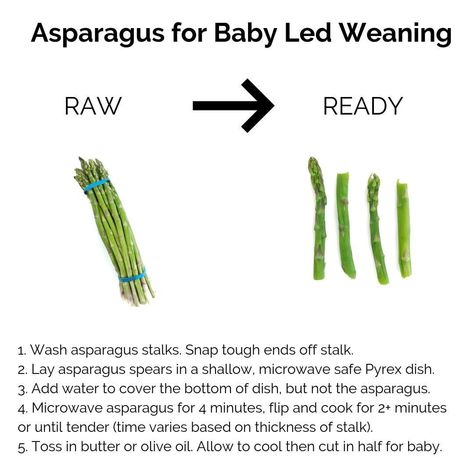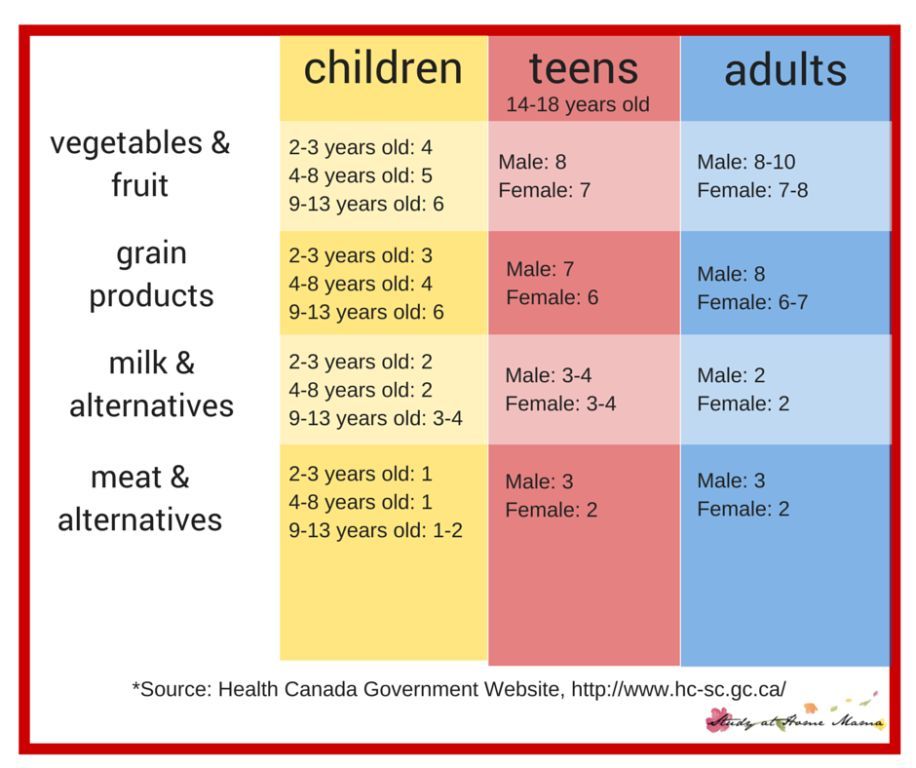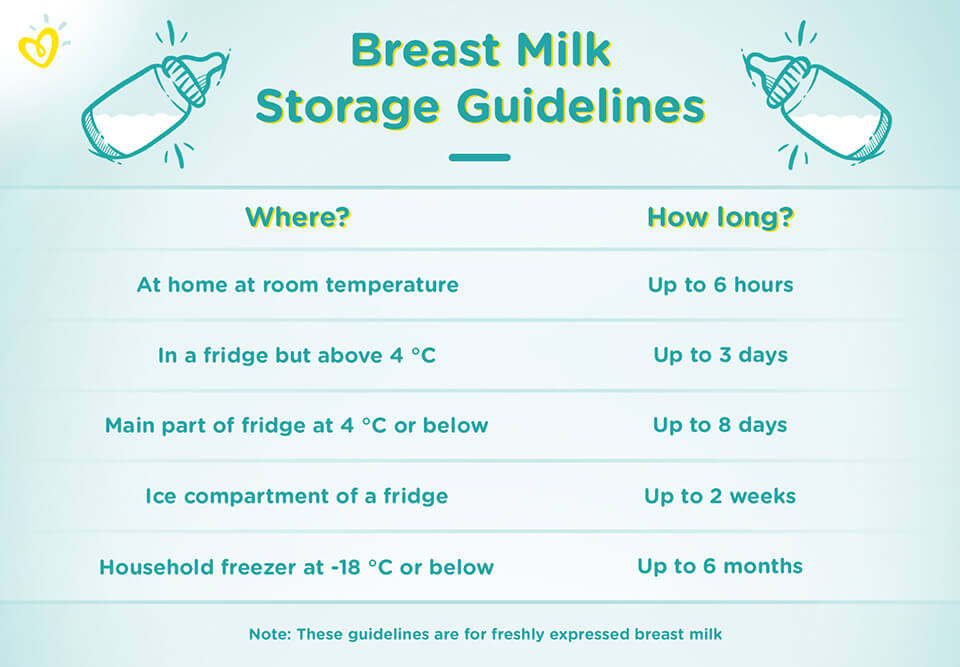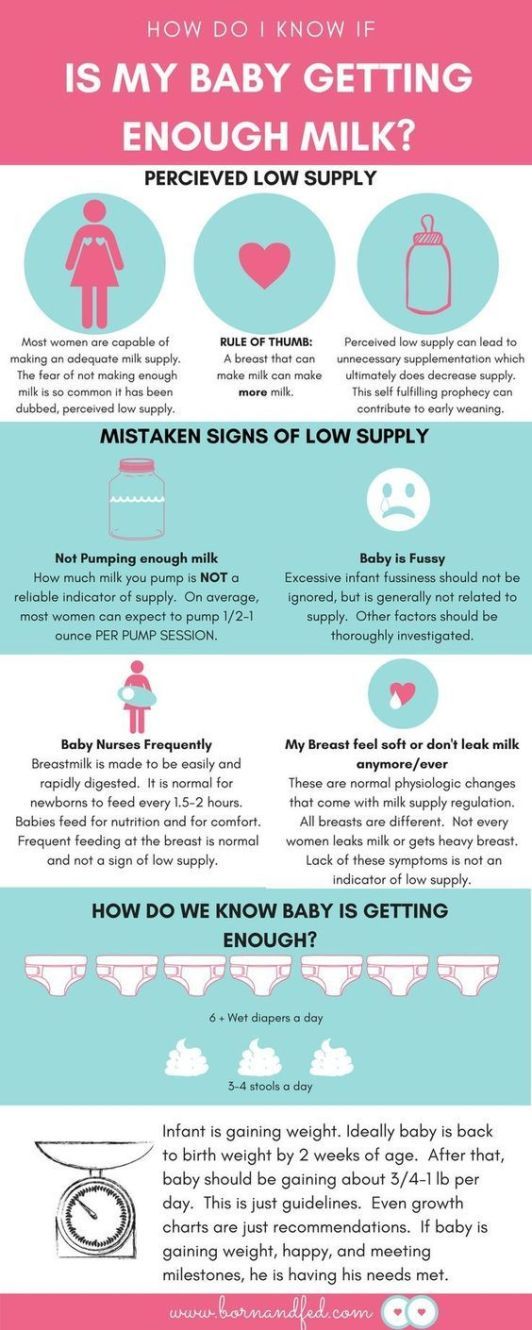Budgie feeding baby
Hand-raising and care of budgerigars (Melopsittacus undulatus)
Corina Gardner
Introduction
Budgerigars (Melopsittacus undulatus) or "budgies" are psittacine birds that belong to the order Psittaciformes. Budgerigars are originally from the grasslands, scrublands and open woodlands of Australia, and were first recorded in 1805. These little seed eating birds live in large flocks in Australia and feed on native grasses like Spiniflex, Mitchell's and Tussock, and plants such as Saltbush (Orache) and Tar vine (Red spiderling). They will also readily consume wheat and wild millet. They usually forage on the ground for food. In their natural habitat budgies nest in cavities in trees and hollow tree trunks as well as logs on the ground and often choose to live near bodies of water.
Captive bred budgerigars are found in an array of beautiful colors. These low-maintenance, lively birds make popular pets as they are very easy to tame, very energetic, playful, affectionate and intelligent. These little chatterboxes also make wonderful mimics. The males are more vocal than the females. They are also very social birds and enjoy the company of humans, in fact, people in the house inevitably become the bird’s family. The life span of budgies in captivity is anywhere from 5-15 years.
It is difficult to distinguish between young males and females, until the cere (the area on the upper part of the beak containing the bird’s nostrils) turns a distinct blue at roughly the age of 4 months for male parakeets. The female’s cere is pale brown or white, while the cere in pale pink in immature birds of both sexes.
General guidelines for hand-rearing baby Budgerigars
Hand rearing often becomes necessary when young and inexperienced parents may abandon their nests and refuse to feed baby birds. Such a situation would demand immediate intervention and you will have to care for the baby birds yourself.
Feeding and hygiene
A disposable syringe, which is easily available in most medical stores, can be used for feeding the young birds.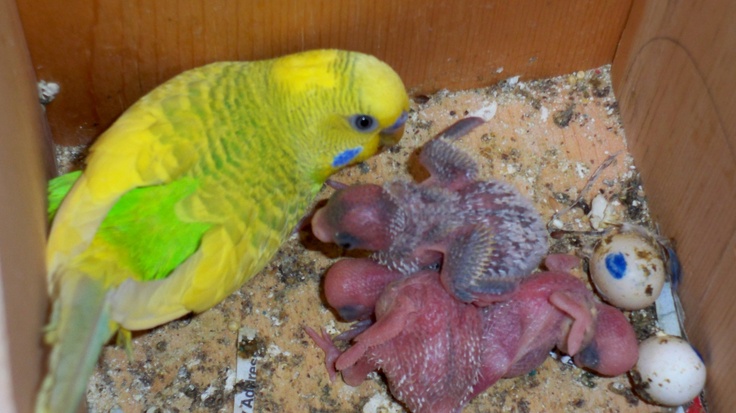 Syringe feeding is faster and less messy. However, if unavailable, then the next best alternative would be to use an eye dropper or a plastic teaspoon. Spoon feeding maybe lengthy and messy, but its ultimately beneficial as you could use thicker consistency food towards the end of the hand rearing process. The slender tip of the spoon can be dipped in boiling water and then bent make a funnel, thus making it easy to use for hand feeding.
Syringe feeding is faster and less messy. However, if unavailable, then the next best alternative would be to use an eye dropper or a plastic teaspoon. Spoon feeding maybe lengthy and messy, but its ultimately beneficial as you could use thicker consistency food towards the end of the hand rearing process. The slender tip of the spoon can be dipped in boiling water and then bent make a funnel, thus making it easy to use for hand feeding.
The last option would be a crop needle (medication tube). Crop feeding is the fastest, most effective method of feeding. A piece of pipe is fitted in front of the syringe and inserted through the beak into the crop. Crop needles, should be the last option and only used by an experienced handler as it can perforate the crop if not used carefully.
Feeders should be disinfected before and after use. The feeders (spoon, syringe or dropper, or crop needle) must be rinsed with warm water to remove any feed residues. Mild soap or detergent can be used to clean spoon feeders; however, it’s very essential that it must be washed thoroughly so that no soap residue remains. Droppers, syringes and crop needles all need to be sterilized before use.
Droppers, syringes and crop needles all need to be sterilized before use.
Baby food formula
Baby bird formula, for example, Kaytee Exact, available in most pet stores would be an ideal feed. However, as it is not easily available in some parts of India, baby formula like Cerelac can be used instead. To ensure that the highest levels of hygiene are maintained, only boiled water must be used to prepare the feed. Water must be boiled and then cooled before use or the formula will be too warm for the chicks.
If however, neither of these formulas is available, then a piece of bread can be crumbled in lukewarm milk and fed to the young birds - but I would only use this as a last resort. The formula must be prepared in a glass container as plastic containers tend to harbor bacteria. Never prepare formula in dirty containers. Prepare food for just one feed at a time, and always discard any leftover food.
The consistency of the formula should be similar to that of a soft pudding – neither too thick, which would make it difficult for the baby to swallow and it may choke, nor too diluted as the baby could inhale the formula into its lungs causing aspiration. The formula must only be heated adequately before feeding the baby. Formula that is too hot will scald the baby bird’s crop, causing crop burn. Crop burn is the scalding of a chick’s crop and esophagus. For the same reason, formula must never be heated in a microwave. Formula which is microwaved causes hot spots – such unevenly warmed-up food will scald the bird’s crop causing crop burn. On the other hand, formula that is cold will cause ‘sour crop’. Sour crop is a condition in which the formula in the baby’s crop has gone bad and the contents of the crop has not emptied.
The formula must only be heated adequately before feeding the baby. Formula that is too hot will scald the baby bird’s crop, causing crop burn. Crop burn is the scalding of a chick’s crop and esophagus. For the same reason, formula must never be heated in a microwave. Formula which is microwaved causes hot spots – such unevenly warmed-up food will scald the bird’s crop causing crop burn. On the other hand, formula that is cold will cause ‘sour crop’. Sour crop is a condition in which the formula in the baby’s crop has gone bad and the contents of the crop has not emptied.
Feeding instructions
The baby bird can be placed on a napkin or towel on a table or kitchen counter so you can feed the baby in a comfortable position. Our aim is to emulate the parent bird as much as possible and provide a simulated environment that is as close as possible to its natural setting. Parent birds tap on the baby bird’s beak to stimulate the feeding response. So, gently tap the bay bird’s beak with the feeding instrument in a similar manner to encourage the feeding response. The feeding response is when the baby senses food and gapes, bobbing its head up and down. Parent birds then feed their chicks by inserting their beaks at an angle, through the side of the baby’s mouth. They then regurgitate the food deep into the baby bird’s mouth. Therefore, insert the tip of the feeding syringe at an angle at either sides of the baby’s beak. Press the plunger slowly, stopping every now and then, so as to allow the baby time to swallow. The speed of feeding must never be hastened. Enough time must be allowed for the baby to swallow its food before pressing on the plunger any further.
The feeding response is when the baby senses food and gapes, bobbing its head up and down. Parent birds then feed their chicks by inserting their beaks at an angle, through the side of the baby’s mouth. They then regurgitate the food deep into the baby bird’s mouth. Therefore, insert the tip of the feeding syringe at an angle at either sides of the baby’s beak. Press the plunger slowly, stopping every now and then, so as to allow the baby time to swallow. The speed of feeding must never be hastened. Enough time must be allowed for the baby to swallow its food before pressing on the plunger any further.
Once its crop is full, not over-extended, and it has had enough to eat, the baby will stop gaping and refuse to open its beak. Feeding must be stopped immediately. Over feeding can cause formula to flow into the throat and down its windpipe, which can be life threatening. The baby must not be forced to feed when it is reluctant to accept food. The beak and feathers of the baby must be wiped gently with a warm, damp cloth after feeding.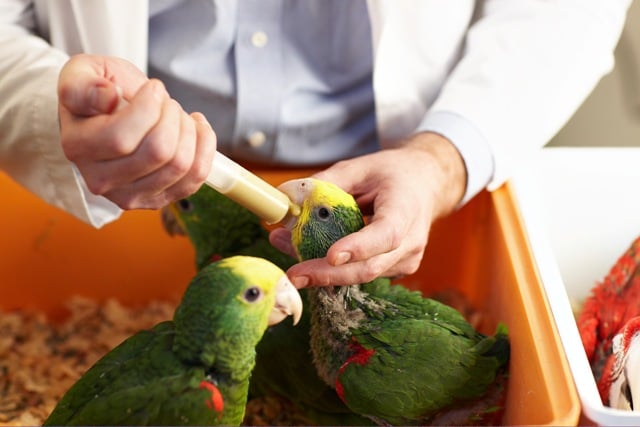
The baby’s crop usually empties within 4 hours. A crop that remains full or does not empty completely within that time indicates that there is a problem. Never feed the baby while there is leftover food in the crop, instead pour a few drops of lukewarm water into the bird’s beak and gently massage the crop, NEVER press too hard. The crop is a muscular pouch near the throat of the baby bird that is used to store excess food for subsequent digestion.
Stage-wise care of the chicks
1st Week
New born budgies are born pink, featherless, blind and totally helpless. The baby budgies’ peeps are a lot louder by day 5 and their movements increase. Even though their eyes are still closed, they can hold their head up by day 7. Fluffy down begins to cover the chicks in the first week of their lives.
Ideally, feeding should start at 6 a.m. and continue until midnight. The baby should be fed every 2 hours. A day old chick would require approx 1 ml of formula per feed, which can be gradually increased to 2 ml by the 4th day and 3 ml by 7th day. It is unnecessary to give the baby any additional water as they receive sufficient fluids in their feed itself. It is also unnecessary to feed the baby at night as in nature, parent birds as well as their babies sleep at night.
It is unnecessary to give the baby any additional water as they receive sufficient fluids in their feed itself. It is also unnecessary to feed the baby at night as in nature, parent birds as well as their babies sleep at night.
2nd – 3rd Week
Pin feathers begin to erupt in the second week of the baby’s life & the eyes usually open around the 8th -10th day. By the 3rd week the baby is covered with down, and pin feathers and tail feathers are also visible.
By the 2nd week, the baby can be fed every 3 hours. The feed quantity must be increased to 4 ml per feed. Feeding must still begin by 6 a.m., however, the last feed could be given by 10 p.m.
The consistency of the formula can be thickened by the 3rd week and the feed quantity can progressively be increased to 5 ml per feed. The frequency of feeding can be decreased to a feed every 4-5 hrs.
4th – 5th Week
The baby birds start to develop flight feathers by this age and are now called fledglings.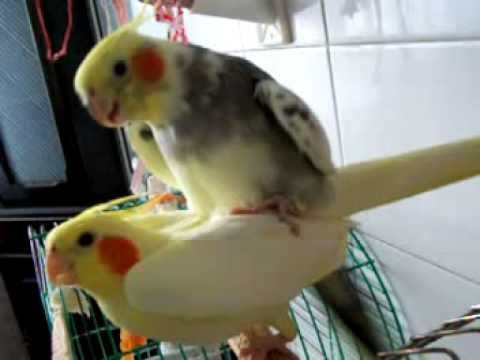 They also start foraging (searching for food) themselves by this age. Scatter some grain on the floor of the cage as soon as the chicks leave the nest; this encourages them to peck for themselves. Feed quantity can now be increased to 6 ml per feed and the frequency of feeds can be decreased to 2-3 feeds a day. The weaning process must begin by the time the baby is 5 weeks old.
They also start foraging (searching for food) themselves by this age. Scatter some grain on the floor of the cage as soon as the chicks leave the nest; this encourages them to peck for themselves. Feed quantity can now be increased to 6 ml per feed and the frequency of feeds can be decreased to 2-3 feeds a day. The weaning process must begin by the time the baby is 5 weeks old.
Weaning foods such as greens, bits of toast and bread, crushed and grated boiled eggs (along with the shell) and cream cracker biscuits can now be offered to the young birds. This mixture is an easily digestible substitute and ideal during rearing of young birds. Mixed bird seeds such as millet (durra), foxtail millet (kheri), finger millet (ragi), sunflower seed, etc. should also be given to the birds.
6th – 7th Week
The young bird is quite independent now and must be transferred to a cage. Although they feed well by themselves at this age, they must be watched vigilantly to ensure they are eating well. If necessary, feedings can be continued once or twice a day for a few more days.
If necessary, feedings can be continued once or twice a day for a few more days.
Once shifted to a cage, it must be ensured that the cages are spacious enough to allow free movement between perches. Perches should be placed just above the floor of the cage so that the bird can easily climb onto them. Place a shallow bowl of water at the bottom of the cage. The cage must be located in a well lighted location with a source of natural light such as sunlight, but well away from direct sunlight. Avoid exposing the birds to a cold breeze or draught, especially at night, as this causes chills and other health problems.
Fresh, natural branches of Indian lilac or neem (Azadirachta indica) and other trees should be provided as perches as this helps to keep the feet and claws of the birds healthy and strong. It not only strengthens their jaws and sharpens their beaks but keeps them occupied as well. Birds are otherwise prone to boredom and feather plucking.
It’s advisable to cover the cage with a cloth at night as it gives the bird a feeling of security.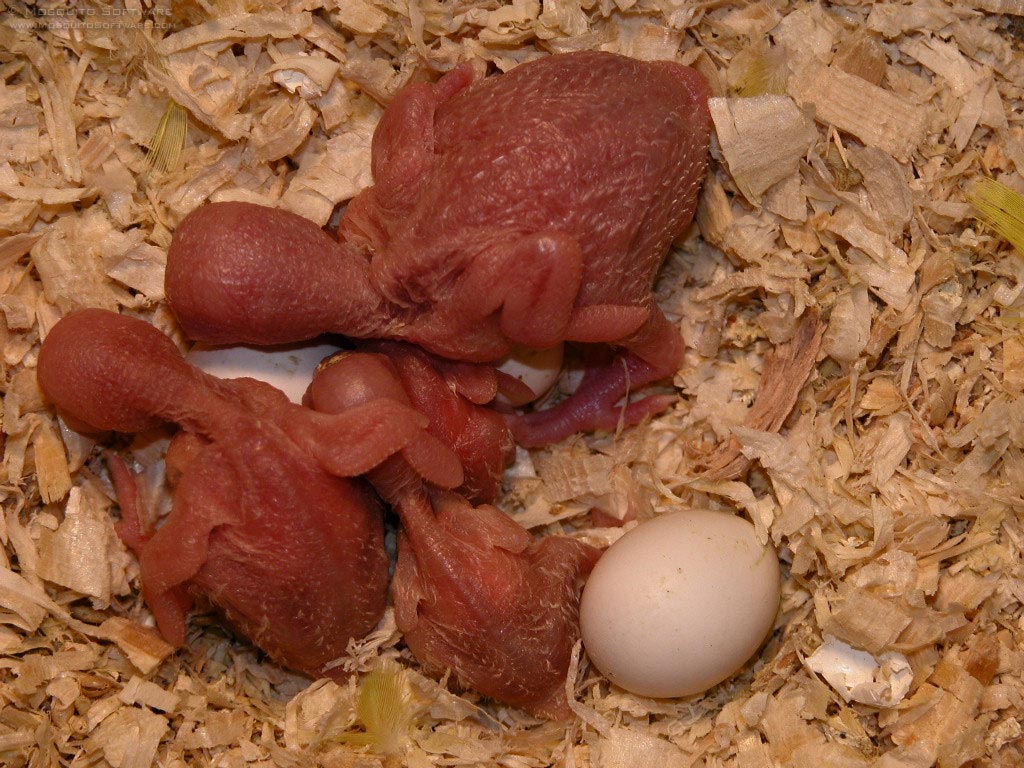
8th- 9th Week
By 8 to 9 weeks of age, the bird should be completely weaned.
The young birds will attain their adult plumage by 3-4 months of age.
Adult bird diet
Mixed bird seed, which is available in most pet stores, should also be given to the bird. In the event that bird seed is unavailable then large millet seed (bajra), finger millet (ragi), foxtail millet (kheri), sunflower (suraj mukhi) seed, safflower (beni or kardi) seed, pumpkin (kaddu) seed (pepitas), boiled maize (makki) and soaked gram (chana) can be provided. It’s always advisable to offer the young bird’s entire or un-hulled seeds as hulled seeds tend to decay and mold.
Seeding grass, French beans, and carrots are always a welcome treat as well. Green leafy vegetables such as lettuce, mustard sprouts, millet sprouts and fenugreek (methi) leaves is essential along with other weaning foods. Cuttlebone is a good source of calcium, and also helps trim their beaks.
Foods that must be avoided
Foods that are toxic for cockatiels include apple pips, avocado (makhanphal), cherries and peaches (aadu).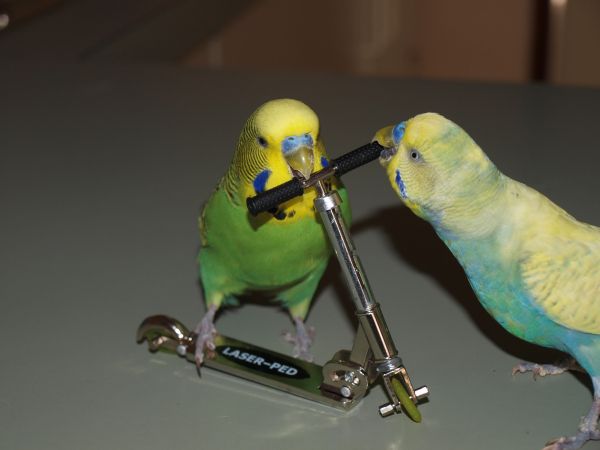 Never give your birds chocolate, as it may make your bird seriously ill.
Never give your birds chocolate, as it may make your bird seriously ill.
Housing the young birds
A shoe-box or small cardboard box with adequate holes for ventilation, a wicker basket or even a small aquarium may be used to house the young birds. The box can be lined with a soft towel at the base and a few layers of tissue papers on top of the towel, making it easy to change the paper towels when dirty. The box must be placed in a warm, dry place, preferably near a source of warmth. A heating lamp, with a light bulb of maximum 40 watts, can be placed above the box. The lamp must be placed at least 12” away from the box. The ideal temperature for the baby birds would be about 35.5° Celsius (or 96° Fahrenheit). Again, it is crucial to be vigilant and ensure that the baby is not being overheated. A clear indication of overheating would be when the baby’s beak is open (as if panting) and wings are held away from its body. On the other hand, if it’s huddled and shivering, it is not receiving enough warmth. At night, partly cover the box with a light towel to keep out the light from the heating lamp and thus enable the baby to sleep.
At night, partly cover the box with a light towel to keep out the light from the heating lamp and thus enable the baby to sleep.
It must be noted that the purpose of the lamp is to provide warmth alone, and not light, and it must never interfere with the natural light patterns and disrupt the baby bird’s sleep cycle. In nature, budgies nest in hollow tree trunks in wooded areas, where not much light enters. Even when in captivity, the parent bird sits on the baby, shielding it from most of the light.
The heating lamp may be discontinued after the baby crosses 2-3 weeks of age and is covered with its first layer of feathers. Ants are a real danger to baby birds and can fatally hurt them. It must be ensured that there are no ants in the vicinity of the bird.
Housing for breeding
Cages for breeding budgerigars should be an average size of 20”X20”X50”. The nest-box in the breeding cage should be 9”X11”X12” with a 2” opening. The nest-box can be mounted on the outside of the cage. Most cages now come equipped with a small door at the side of the cage which can be used as an entry to the nest-box. If on the other hand birds are housed in aviaries then the box can be placed inside the aviary itself. Nesting material should consist of pine shavings, shredded paper & freshly cut grass.
Most cages now come equipped with a small door at the side of the cage which can be used as an entry to the nest-box. If on the other hand birds are housed in aviaries then the box can be placed inside the aviary itself. Nesting material should consist of pine shavings, shredded paper & freshly cut grass.
The female budgie lays her eggs on alternate days until the female lays about 4 or 6 eggs. Incubation occurs soon after the hen lays the 2nd egg, and the first chick hatches after 18 days. Do not disturb the parents when they are sitting on the eggs. The female rarely leaves the nest and is fed by the male. Once the chicks hatch they are fed by their parents, who bring up a thick, milky substance which forms in their crops. However, if you find that the parents are not feeding the baby and the baby is getting progressively weaker, then the only option would be that the baby would have to be removed from the nest and hand fed. Keep in mind that a newborn baby is often not fed for about the first 8 hrs of its life.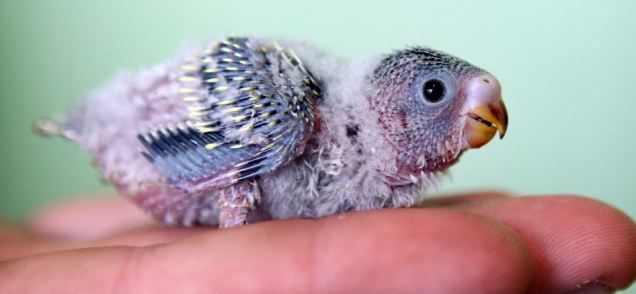
Feather care
Preening
Budgies frequently preen their feathers. Birds use their beaks to preen their feathers and keep them in good condition. Preening is an essential way for birds to keep their feathers neat and trim.
Molting
The first molt of a budgie occurs when the budgie is around three months old. Molting is a natural process when the baby feathers are replaced by brighter plumage, after the first molt the budgie molts throughout the year and loses a few feathers every now and then.
Bathing your bird
A bath once or twice a week during the summer months and once a week in the winter or monsoons should suffice. Birds that enjoy their baths would appreciate frequent opportunities to bathe, while those that don’t must not be forced. Each bird is different and some may prefer a spray of water while others may prefer a dish of water.
Spray misters or plant sprayers (plant atomizer mister) are ideal giving your bird a mist bath. The mister may be filled with warm water – hot water must never be used. Spray just above the bird’s head, so that the spray settles gently on the bird. It’s also a good practice to provide a shallow dish of water for the birds to bathe in.
The mister may be filled with warm water – hot water must never be used. Spray just above the bird’s head, so that the spray settles gently on the bird. It’s also a good practice to provide a shallow dish of water for the birds to bathe in.
Many a time you’ll find your bird flapping its wings and hanging upside down from its perch, this usually indicates that the bird wishes to bathe. Some may even sit in their water bowl or dip their head in-and-out of the bowl to indicate their wanting to bathe. You will know that he is enjoying his bath when he puffs out his feathers, raises both his wings up and away from his side and leans forward.
Signs of distress
If the budgie sits quietly with his feathers rumpled up, and you notice green watery droppings, he's probably got a chill. In the event that the bird suffers an upset stomach or diarrhea, indications of which include watery green droppings, a pinch of Ridol or Kaltin or any other binding tablet can be crushed and mixed in a half container of water and offered instead of plain drinking water. Although the bird should be better in a day or two, the medicine may be added for an additional day to ensure complete healing.
Although the bird should be better in a day or two, the medicine may be added for an additional day to ensure complete healing.
Egg binding
Egg binding is a medical condition when a female bird is unable to expel an egg. Egg binding can pose a serious threat to cockatiels. Younger females are at a greater risk of dying from egg binding. In the event that a female cockatiel is suddenly puffed-up and listless, it is quite likely due to egg-binding.
The female must immediately be placed in a small cage or shoe-box and provided with quiet and additional warmth. A heating lamp would be ideal. Castor oil or even cooking oil can be gently applied in to the birds vent or cloaca, with a Q-tip (a cotton bud) to lubricate the area and facilitate the passing of the difficult egg. One drop of castor oil given orally will also help the passage of the egg. If these basic requirements are provided it is unlikely that the bird will suffer any serious health issues.
Release of birds
Release of pet birds into the environment is just not an option. Lengthy durations of time spent in captivity can result in loss of survival capability. Hand-reared birds and ‘cage birds’ usually lack the survival capability to defend themselves and will become easy prey. And as they are vulnerable and unable to fend for themselves, they will surely be attacked and killed by other predatory birds such as hawks, kites, shikras, crows, etc. Another factor would also be locating shelter in bad weather conditions. They will also be vulnerable to other predators such as cats, snakes, rats, etc. unless they can locate for themselves a safe place to roost.
Lengthy durations of time spent in captivity can result in loss of survival capability. Hand-reared birds and ‘cage birds’ usually lack the survival capability to defend themselves and will become easy prey. And as they are vulnerable and unable to fend for themselves, they will surely be attacked and killed by other predatory birds such as hawks, kites, shikras, crows, etc. Another factor would also be locating shelter in bad weather conditions. They will also be vulnerable to other predators such as cats, snakes, rats, etc. unless they can locate for themselves a safe place to roost.
They also have a huge disadvantage competing for food. In their natural habitats, birds such as budgies, cockatiels, lovebirds, etc. forage for grain, feed on grass seeds, leaves, vegetables and fruit. Locating such food sources, especially in environments in which they are not native, would be extremely difficult. Needleless to say, this would be even more difficult in a city.
It must also be noted that the color of wild budgies is green, which gives them superb camouflage and helps them blend in with the environment. Captive-born budgies, on the other hand, are available in an array of colors from a stunning white to bright yellows and blues. These birds are so brightly colored that they completely stand out against the native fauna and easily attract the wrong attention and fall prey. Their chances for survival are therefore be extremely slim and such birds must never be released in the wild.
Captive-born budgies, on the other hand, are available in an array of colors from a stunning white to bright yellows and blues. These birds are so brightly colored that they completely stand out against the native fauna and easily attract the wrong attention and fall prey. Their chances for survival are therefore be extremely slim and such birds must never be released in the wild.
References
Edmund Wyndham (2006) Environment and food of the budgerigar Melopsittacus undulates. Available from:
http://onlinelibrary.wiley.com/doi/10.1111/j.1442-9993.1980.tb01231.x/abstract [Accessed: 24/06/2012]
Rob Marshall and Jean Marshall (2004) Breeding behaviour of the wild budgerigar. Available from:
http://www.birdhealth.com.au/bird/budgie/wildbudgie.html[Accessed: 24/06/2012]
Roman Tronicek and Gaby Schulemann-Maier (undated) Birds online: Everything about budgies. Available from:
http://www.birds-online.de/allgemein/australien_en.htm [Accessed: 24/06/2012]
Photographs used
Corina Gardner.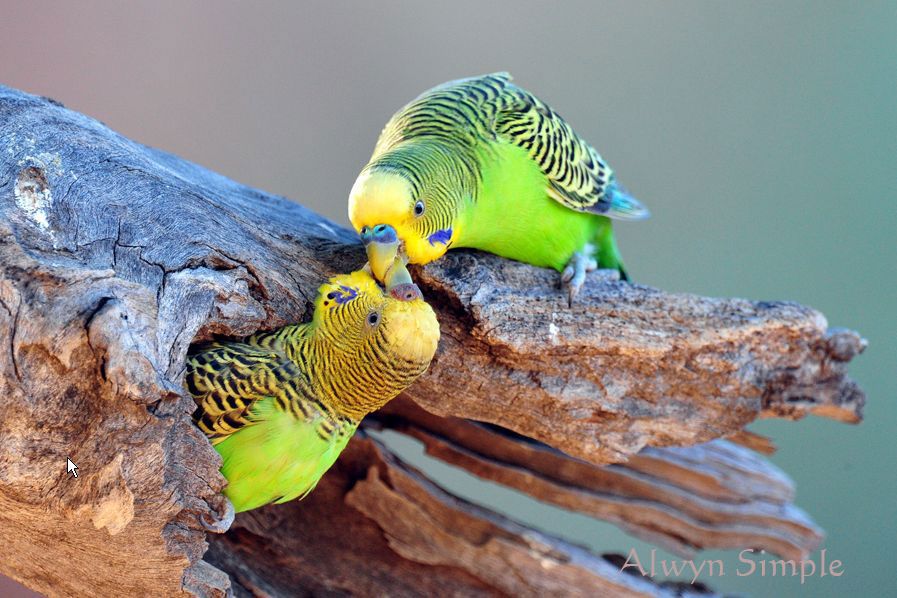 Bent spoon feeder.
Bent spoon feeder.
Devna Arora. Disposable syringe feeder.
Isidro Vila Verde. Adult budgie. Available from:
http://www.flickr.com/photos/jvverde/510026697/sizes/z/in/
photostream/ [Accessed: 10/06/2012]
Julian Robinson. Female and male budgerigars. Available from:
http://www.flickr.com/photos/ozjulian/4374205181/sizes/o/in/
photostream/ [Accessed: 10/06/2012]
Julian Robinson. Wild flock of Budgerigars. Available from:
http://www.flickr.com/photos/ozjulian/4025170161/sizes/o/in/
photostream/ [Accessed: 10/06/2012]
Kutzo Cat. 1-7 day old baby. Available from:
http://www.flickr.com/photos/29320814@N03/3266883173/sizes/
o/in/photostream/ [Accessed: 15/06/2012]
Kutzo Cat. 1 month old budgie chicks. Available from:
http://www.flickr.com/photos/29320814@N03/3421376267/sizes/
o/in/photostream/ [Accessed: 15/06/2012]
Max Exter. Budgies bathing: Available from:
http://www.flickr.com/photos/mexter/132987384/sizes/z/in/
photostream/ [Accessed: 12/06/2012]
Michael, DK.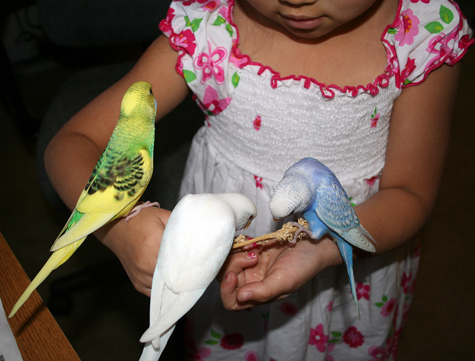 3 week old budgie. Available from:
3 week old budgie. Available from:
http://www.flickr.com/photos/michael_l/652427161/sizes/z/in/
photostream/ [Accessed: 11/06/2012]
Edited by Devna Arora
Published in 2012
Feeding Baby Parakeets | Parakeet Chicks | Parakeets | Guide
Rearing chicks by hand is very time-consuming, and should not be done without full appreciation of what’s involved. Always make sure to seek expert advice for any aspect of chick-feeding, and take time to watch some instructional videos. This will boost your confidence and minimise the chance of you messing something up.
Even if you have a healthy pair of birds doing all the hard work for you, you should still know what to do if things don't quite go to plan. Mishaps could be anything from a sick male bird (meaning that he won’t be able to feed the hen) to an abandoned nest. Baby parakeets are very delicate creatures, and if the mishap occurs early in the rearing process -- within the first two weeks -- your chances of successfully weaning the birds are slim. Rearing a freshly-hatched bird is something none but the most experienced breeder should attempt.
Rearing a freshly-hatched bird is something none but the most experienced breeder should attempt.
A six-week-old parakeet
Feeding Parakeet Chicks
There are several parakeet chick feeds and additives that can be purchased online or in larger pet-stores.These should offer the correct mix of nutrients, vitamins and minerals needed to raise the chicks. Always make sure to consult with an expert before opting for any particular brand. Don’t be tempted to make a choice based on price, as cheap mixes are often not good enough for such fragile, young creatures.
Chick food should be mixed according to the instructions on the packet. It will usually have a gloopy consistency, and, like Baby Bear’s porridge, should be neither too hot nor too cold. If the feed is too hot, it can scald the bird’s crop and throat: if too cold, it may lodge itself in the chick’s crop and lead to a fatal condition known as “sour crop”. Again, just make sure you read the instructions.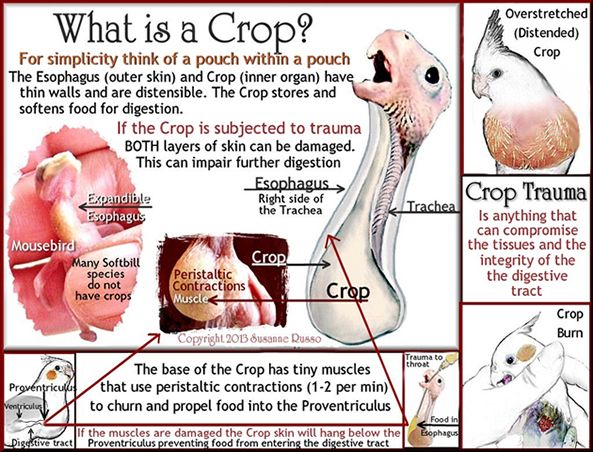
The food each chick receives should be carefully measured, and should be served at a temperature similar to that of the regurgitated seed of an adult bird (the chick's natural food source). You can use a thermometer to measure the temperature precisely. Never be tempted to heat up the food quickly in the microwave, as this can lead to hot spots in the food. An ideal temperature for this food is between 105-110F.
How to Feed Parakeet Chicks
The food can be offered on a plastic spoon with bent edges (dip the end of a standard plastic teaspoon in boiling water and then bend the edges inward -- this funnels the food into a relatively narrow gap), or alternatively you can feed them via a wide-nozzle syringe. Many breeder rig up their own spoon-syringe hybrid
The syringe is good as it allows you to measure the quantity of food you are administering` There are however choking hazards to beware of though, so a spoon is advisable once the chick is old enough to feed this way (at around 10 days old). The spoon allows the chick to swallow the food at it’s own pace, but does not recreate the “regurgitated seed” flow as well as the syringe.
The spoon allows the chick to swallow the food at it’s own pace, but does not recreate the “regurgitated seed” flow as well as the syringe.
Experts may sometimes opt for a “crop-needle”, this is a tube attached to the end of a syringe and inserted directly into the chick's crop. This takes a lot of care, however, and should not be attempted if you don’t know exactly what you’re doing.
No matter what feeding method you opt for, make sure all equipment is suitably sterilized before giving it to the chick, and any unused food should be discarded. Always make the food fresh and refrain from preparing it ahead of time.
Keeping a young chick warm whilst feeding them is also important. They should be placed onto a cosy towel or similar soft object for feeding. The aim here is to impersonate a soft, warm hen.
Gently tap on the bird’s beak with your spoon or syringe, just like it’s mother would. The bird will obligingly gape (open it’s beak to receive the food). Deliver the mixture sideways on, coming in at a 90 degree angle to the front of the beak (i. e. don’t feed from the front, as this could force the upper part of the beak too far upwards, and it’s not the way parent birds approach the job).
e. don’t feed from the front, as this could force the upper part of the beak too far upwards, and it’s not the way parent birds approach the job).
Don’t syringe or pour in all the food at once. The chick needs time to swallow, and can easily choke on too much too soon. It will let you know when it’s had enough, by simply closing its beak and refusing to reopen. If the bird hasn’t eaten its usual amount, don’t force-feed it. If the lack of appetite persists for the next few feeds, seek medical advice. A blocked crop can sometimes be remedied with a small squirt of warm water and some gentle crop-massage – but you really need to know what you’re doing. Always have the vet or breeder’s phone details at hand.
The food will have cleared from a healthy chick’s crop within 2-4 hours depending on it;s age, and it will need feeding every 3-4 hours. As stated above, if your chick isn’t hungry, it won’t gape. Feeding is a full time job, at least six times a day, and you can only retire at sunset. No one said this is going to be easy!
No one said this is going to be easy!
baby parakeets grow alarmingly quickly, and their food intake needs to grow with them. At two weeks old, depending on the chick’s size, they will take 2-4ml at each feed. At three weeks this increases to 4-6ml, and 5-8ml by five weeks old.
Feeding a 3 Week Old Parakeet
Things become much easier at 3 weeks old. The parakeet chick will now resemble an unkempt miniature dinosaur, with a rather ugly mix of down and pin feathers, and a lot of the character and curiosity that will stay with them throughout their lives. At this point in their lives feeding won’t be such a challenge. Usually every four hours. The bird will happily receive your attentions throughout 16 hours on a long summer’s day, though.
A five-week-old parakeet
Feeding a 5 Week Old Parakeet
At around 5 weeks old you can start putting food on the ground or in bowls, and letting the parakeet indulge in its natural instinct to forage. At around 6-7 weeks old the bird should be fully self-sufficient. You will still need to keep an eye on their feeding behavior, however, as not all parakeets become independent as swiftly as the average bird. Some hand feeding may still be in need at seven weeks old.
At around 6-7 weeks old the bird should be fully self-sufficient. You will still need to keep an eye on their feeding behavior, however, as not all parakeets become independent as swiftly as the average bird. Some hand feeding may still be in need at seven weeks old.
What to feed budgie chicks?
After birth, budgerigars are defenseless, they are completely dependent on their parents. The female feeds and pays attention to each of them, despite the number of offspring and their age difference.
In the beginning, feeding of babies consists of regurgitation by the female of crop milk, which is located in the gizzard. This "milk" is not one substance, it is a yellowish mucus, consisting of very small, almost liquid pieces of food and protein-rich crop milk. A few days after the birth of the chicks, partially digested grain from the goiter is mixed with the "milk". nine0003 Photo: parrots4life
Thanks to sprouted grains in the diet of a lactating female, she produces a sufficient amount of crop milk.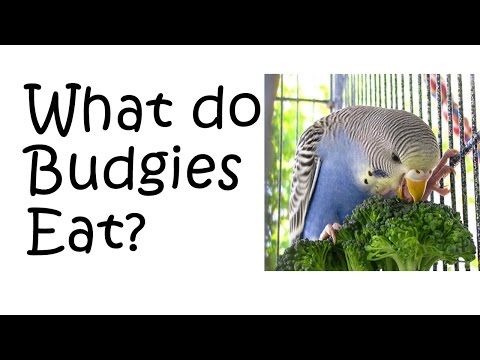
Later, as the parrots mature, the older ones are transferred to grain feed. Since the grain is in the crop, the female feeds the grown chicks first, and when the grain runs out, the crop milk goes to the smallest in the family.
Photo: BikaDuring this period, the male constantly provides the female with everything she needs, as she can leave the nest only in the morning and evening, and even then not always. Sometimes the male helps the female and participates in feeding. He also processes grain feed in the goiter, like the female. Thanks to this, the digestive system of budgerigar chicks works like clockwork, they receive the most nutrients, vital enzymes and boost their immunity. nine0003
Having flown out of the nest for the first time, young parrots most often remain under the care of the male, as the female is going to the second clutch.
The nutritional value of the parents depends on the owners. It is very important to add and exclude certain products in time.
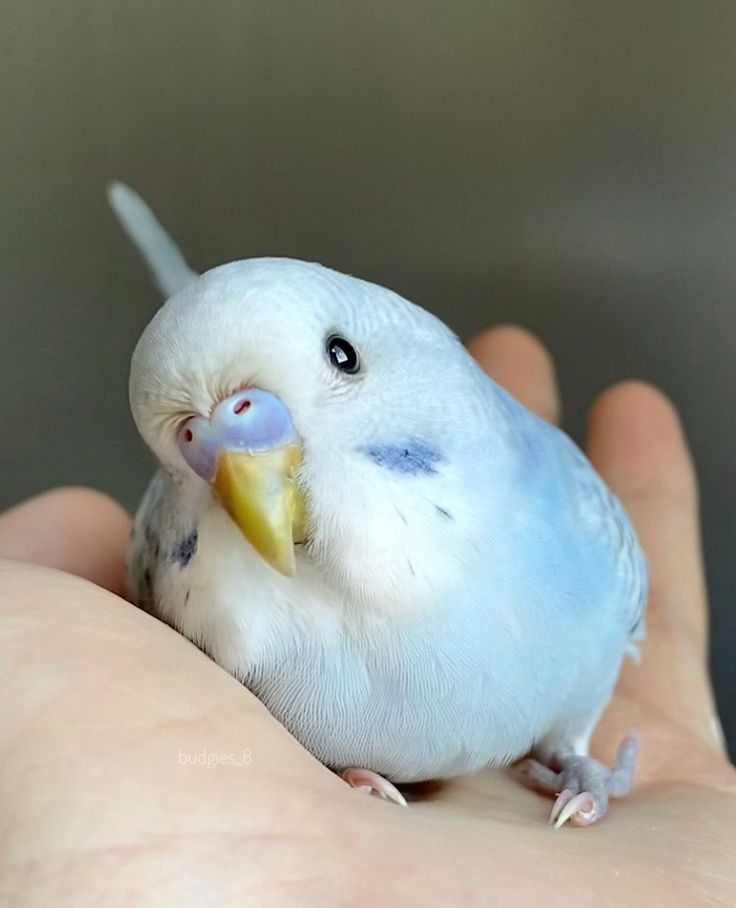
Feeding a young couple during breeding can be found here.
It happens that breeders have to take on the role of parents of chicks.
Contents
- 1 Reasons for artificial feeding of budgerigar chicks:
- 2 Heating of budgerigar chicks
- 3 There are several options for feeding budgerigars:
- 4 How often to feed budgerigar chicks
Reasons for artificial feeding of budgerigar chicks or failure5: 9003 9003 parents;
- disease of a chick requiring its immediate separation from the feathered family;
- quarantine;
- lack of appetite in the chick, its inability to feed on its own; nine0003
- death or illness of parents;
- a large number of chicks, parents can not cope;
- the female is going to the second clutch and her offspring interferes with her.
The safe period without food for a newly hatched chick is 12 hours.
This is how long a female can go without feeding her baby. And, in case of a non-standard situation, you should count on this period of time to have time to prepare.
And, in case of a non-standard situation, you should count on this period of time to have time to prepare.
You can offer the chick to another pair or offer the male to feed it. Sometimes the bird accepts the baby and thus takes care of him. But it happens that only you can save the situation. nine0003 Photo: ddie gunn
Also, the female is often going to re-lay, her attitude towards the babies may change and you will need to look for additional housing for the young as soon as possible. More often this happens when the chicks are already able to feed on their own, but it happens that the female shows unmotivated aggression early and you need to save the parrots very quickly.
If your chick is only a few days old, then you can only feed with a special factory syringe or a homemade tool. To do this, you will need a 5 ml syringe and a tube that plays the role of a catheter. If you have the smallest chicks, then its diameter should not be more than 2.5 mm and it will be made of strong, soft material without sharp edges.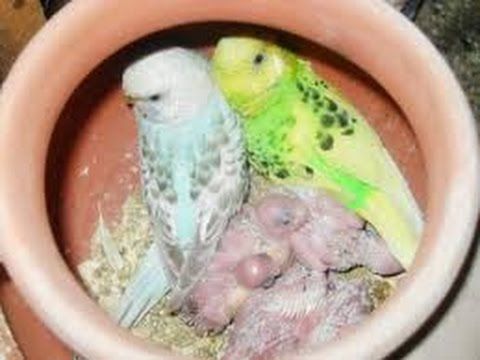 nine0003 Photo: Feeding injector
nine0003 Photo: Feeding injector
You should get rid of the syringe, for this you need to glow the cap and carefully remove the needle, drill a little more hole in the nozzle and put on the tube. Wrap the thread tightly around the edge of the tube and nozzle from the syringe. With a factory syringe, you don’t have to suffer like that - everything is provided for in the design.
The catheter must be lowered into the crop to a sufficient depth - if it is not installed correctly, the feed may enter the bird's trachea, which will lead to its death.
Therefore, having decided to breed budgerigars, you should already have a feeding syringe available. nine0003
Baby budgerigar heating
Also, fledglings require additional heating, which you will have to take care of. Devices that breeders use to keep chicks or sick birds warm are called brooders. You can buy them or make your own.
Photo: Magazine about birds The main thing is to be guided by the temperature parameters, since as you grow, the temperature in the room where the parrot is located should decrease.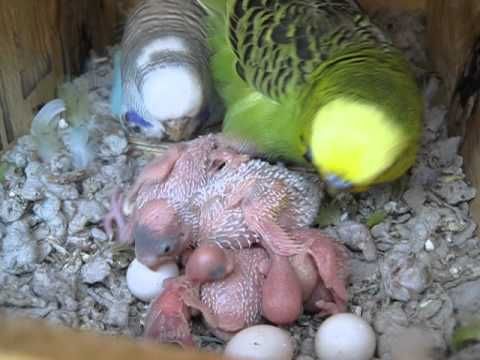
Chick from a few hours to 4 days - 36 - 36.5°C; 7 days - 34°С; 14 days - 31 - 31.5 ° C; Day 21 - 24°C. Further, the chicks are moved to a box, which is similar in size to a nest box, in such a room the parrots themselves will be able to heat each other. nine0003
If you are raising a single chick, keep it in the brooder until day 25, where you lower the temperature to 24°C. Humidity during this period is maintained at 60%, as during masonry.
There are several options for feeding chicks:
Ready mix. Babies need vitamins and nutrients as well as vital enzymes. Therefore, NutriBird A19, a specialized and balanced food for budgerigar chicks, is just right. The mixture must be diluted not boiled, but heated to 39°C with water. Depending on the age of the chick, you adjust the density of the paste. This is the breeder's most convenient feeding option and one of the best ways to give your chick everything it needs to develop a strong body.
You can buy food for chicks - Padovan Baby Patee Universelle.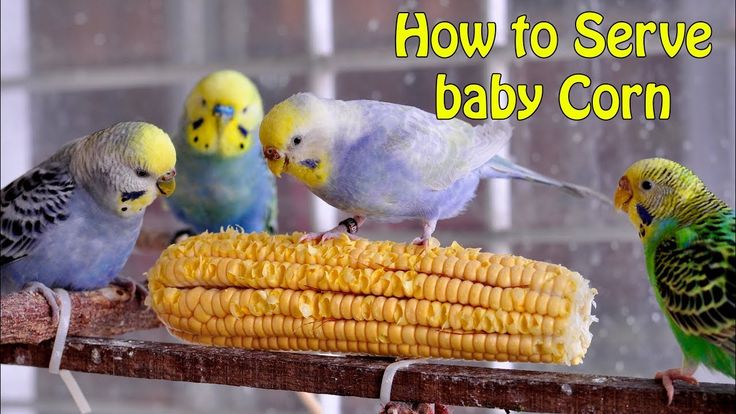 Some breeders have successfully raised young on it.
Some breeders have successfully raised young on it.
Donor bird. Professional breeders use donor birds. Using a catheter, they load a grain mixture into the goiter of a bird, which is later pulled out with a probe. This is an unsafe procedure, so only professionals use this method. The main plus is that the substance that is extracted from the goiter of a parrot is a guarantee that the chick will receive all the vital substances for development. nine0003
Malt milk. A mixture of germinated grains with egg. Malt is prepared from germinated grain, which is crushed and diluted in half with water. Then filter through a strainer and add to the mixture. You should end up with a paste at 39°C.
Medical additive Mezim, Festal, etc. to the porridge. The difficulty lies only in the correct concentration and dilution of these enzymes. It is better to use them together with malt milk.
For power base baby budgerigar, you need to cook baby porridge without milk, sugar and salt: you can boil buckwheat, oatmeal or corn porridge. On the third day of the birth of a chick, you can add vegetable juices to his diet: carrot, beetroot and pumpkin. After the chicks are at least 10 days old, in addition to cereals, you can give a little apple, banana, pomegranate and fat-free cottage cheese.
On the third day of the birth of a chick, you can add vegetable juices to his diet: carrot, beetroot and pumpkin. After the chicks are at least 10 days old, in addition to cereals, you can give a little apple, banana, pomegranate and fat-free cottage cheese.
When the chicks are 20 days old, you can switch them to syringe feeding without catheter or even spoon feeding. From these days, add sprouted grains to the diet (pre-crush into pieces). nine0003
At the age of 30-35 days, the chicks can switch to dry grain, earlier if there is someone nearby who can show them how. But don’t worry, you don’t need to teach this, the chicks successfully begin to taste the grains themselves when the time comes.
How often to feed budgerigar chicks
The smallest chicks should be fed every two hours, at night every 4 hours. Gradually, six feedings with a break for the night are enough for the parrots.
Photo: Dawnstar Australis On the 20th day of life, babies can eat 4 times a day, as they approach 35 days, 3 times will be enough for the chicks.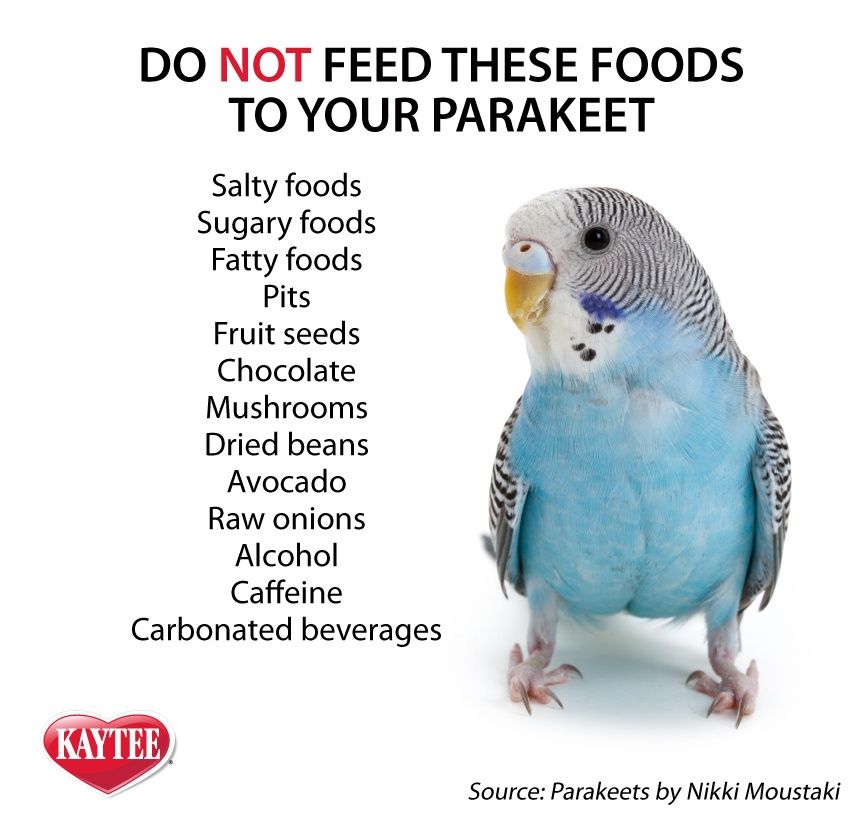 nine0003
nine0003
Babies start to squeak when they are hungry, and the owners, in addition to the feeding schedule, listen to the sounds coming from the cage.
If your older bird is sick, you may need to feed it more frequently.
It is impossible to overfeed a parrot. Do not let the porridge flow out of the beak.
Try feeding them with a spoon, little by little the chicks will get used to it. If among them the eldest is the first to start eating on his own, there will be a chance that he will become an example for the rest of the parrots. nine0003
What to feed a baby budgerigar
Budgerigars are the most popular bird for home keeping. A variety of colors, a cheerful, playful disposition will give a good mood to any owner. Caring for them is not difficult, nutrition does not cause difficulties, but not everything is simple with chicks. The usual offspring of budgerigars is 3–12 babies hatched 18 days after laying eggs, subject to temperature conditions and maintaining the necessary air humidity. Occasionally, two chicks can hatch from one egg. First, the testicles hatch first. At hatching, the weight of the baby is about 1 gram. Every owner who decides to start breeding birds for the first time is worried about the question of how to feed not only an adult bird, but also small chicks. Proper care, maintenance, a competent diet are important for the health, long happy life of pets. nine0003
Occasionally, two chicks can hatch from one egg. First, the testicles hatch first. At hatching, the weight of the baby is about 1 gram. Every owner who decides to start breeding birds for the first time is worried about the question of how to feed not only an adult bird, but also small chicks. Proper care, maintenance, a competent diet are important for the health, long happy life of pets. nine0003
For a year, a pair of budgerigars can hatch offspring 4 times. This should not be allowed: the body of the female is depleted.
Small birds feed on a special substance in the form of a mucous mass mixed with almost liquid pieces of food and protein-rich milk produced in the mother's goiter or muscular stomach. After two or three days, grain, partially digested in the goiter, is added to the milk.
With the birth of babies, they are defenseless, completely dependent on their parents.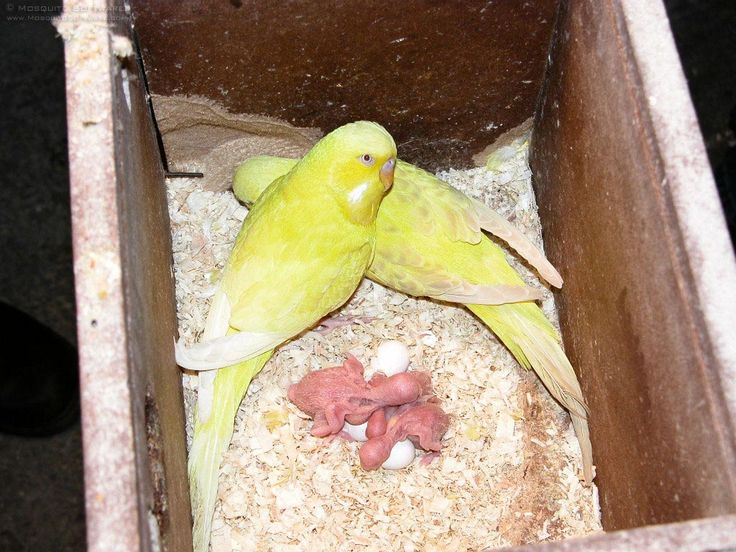 The female cares for, feeds the cubs from her beak, turning each one on its back, regardless of their number and timing of hatching. If the diet of the female contains a sufficient amount of germinated cereals, then the mixture for feeding babies is completely enough. Over time, the grown older birds receive grain food from the goiter, the remaining milk goes to the babies who hatched last. There are cases when, together with the mother, the father also feeds the offspring, in whose goiter grain processing also takes place. Intensive feeding of parrots provides them with all the necessary nutrients and enzymes that ensure the smooth functioning of the digestive tract. nine0003
The female cares for, feeds the cubs from her beak, turning each one on its back, regardless of their number and timing of hatching. If the diet of the female contains a sufficient amount of germinated cereals, then the mixture for feeding babies is completely enough. Over time, the grown older birds receive grain food from the goiter, the remaining milk goes to the babies who hatched last. There are cases when, together with the mother, the father also feeds the offspring, in whose goiter grain processing also takes place. Intensive feeding of parrots provides them with all the necessary nutrients and enzymes that ensure the smooth functioning of the digestive tract. nine0003
The owner of parrots must provide a full menu to parents, changing the diet in a timely manner. It is recommended to constantly add egg mixture, sprouted grains, greens to food.
After leaving the nest, the babies go completely under the care of the male, while the mother is preparing for the next clutch at this time. The feeding period lasts 1.5 months, after which the young become independent from their parents, begin to feed on their own. nine0003
The feeding period lasts 1.5 months, after which the young become independent from their parents, begin to feed on their own. nine0003
Artificial feeding
Sometimes there are situations when the female abandons her children, and the role of the parents of the parrots has to be performed by the owners themselves, feeding without the help of the real father and mother.
It is important to know: if a newly hatched chick does not eat for more than 12 hours, it may die.
Reasons for switching to artificial nutrition at home:
- large offspring, parents are unable to provide food for all children; nine0026
- female aggression, refusal to feed the cubs. Why this happens is difficult to answer. Perhaps she does not have or has not yet awakened maternal instinct. Maybe the reason was that you took a barely born chick in your arms or some other shock for the parrot;
- the baby loses his appetite, and he is not able to eat on his own;
- quarantine or sickness of the baby, requiring the separation of the diseased parrot from other birds for the duration of treatment; nine0026
- death of parents;
- the female is ready to produce the next clutch, the offspring becomes a hindrance to her.
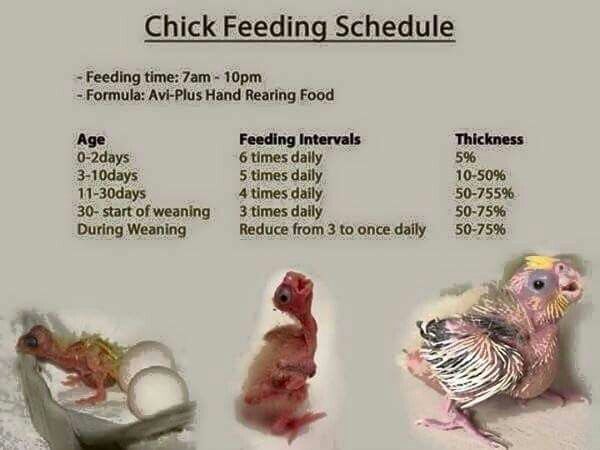
Important to know : food deprivation of a barely born chick for more than 12 hours is critical, can cause death. It is necessary to remember this period and have time to prepare food. Sometimes the remaining one chick can be planted with an outside pair of parrots or another bird species. They will become foster parents to the baby, although the chance of survival of the chick is reduced; otherwise, you should take care of feeding the owner of the birds himself. The best candidates for this role will be Japanese finches, other types of parrots often refuse to accept a stranger, they can injure or peck him. nine0003
It is important for fledgling crumbs to maintain optimal temperature and humidity. To do this, periodically spray the nest with clean water. The temperature in it must be maintained at 33 ° C, lower or higher will cause the death of birds.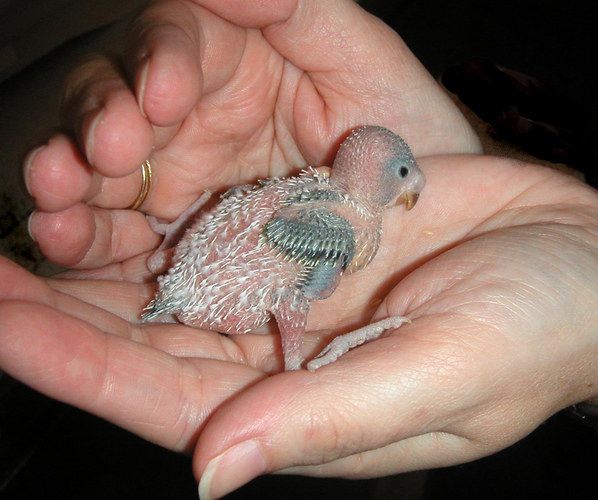 The process can be organized using a cardboard box, constantly warming up its bottom. You can put a warm towel, use an incubator with a set mode that is optimal for chicks. From the twenty-first day, thermoregulation of young animals is improving, additional heating is not required. nine0003
The process can be organized using a cardboard box, constantly warming up its bottom. You can put a warm towel, use an incubator with a set mode that is optimal for chicks. From the twenty-first day, thermoregulation of young animals is improving, additional heating is not required. nine0003
Most experienced breeders advise feeding babies lightly watered down baby food heated to 37°C.
A chick who is two days old is given food using an ordinary insulin syringe or a catheter (cannula) attached to it, made of a plastic tube, wound with a thread. It is necessary to advance the tip further, preventing food from entering the trachea and choking the crumbs. If the bird is not weakened, it immediately begins to swallow food from the first drop. You need to feed until full saturation every two hours, even at night. Such food is given no more than 2 days - it is not intended for long-term feeding of chicks. Remains of food that have stuck to the baby's beak should be washed off with a decoction of chamomile, preventing the growth of bacteria and parasites.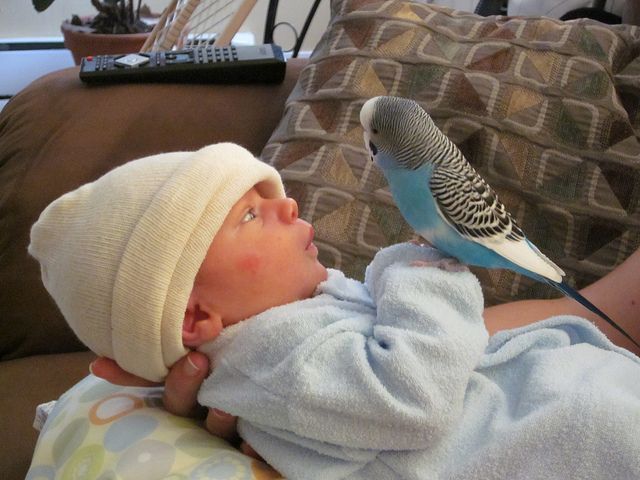 In small birds, food sometimes gets stuck in the beak, leading to cracks, you need to remove the remnants of food with a toothpick. Sometimes female parrots do not clean the paws of their babies, they accumulate leftover food, droppings, which harden during accumulation. In this case, you will have to wash the crumbs yourself. nine0003
In small birds, food sometimes gets stuck in the beak, leading to cracks, you need to remove the remnants of food with a toothpick. Sometimes female parrots do not clean the paws of their babies, they accumulate leftover food, droppings, which harden during accumulation. In this case, you will have to wash the crumbs yourself. nine0003
When artificially fed with a cannula, food is poured not into the beak, but into the goiter, this will prevent the chick from choking on the contents. You can prepare such a mixture: part of baby food, two parts of millet decoction, one part of oat decoction, part of a solution with glucose, vitamins, amino acids.
Foods
There are several types of feeding for newly hatched wavy.
Use of a donor bird
This method is used by experienced breeders who are professionally breeding birds. The grain mixture is fed into the goiter of the parrot through a catheter, from where it is sucked off with a probe in the digested form. A dangerous, but the most effective type of food for artificial people, while all the substances necessary for life will enter the feathered body. nine0003
A dangerous, but the most effective type of food for artificial people, while all the substances necessary for life will enter the feathered body. nine0003
Malt milk feeding
Malt is prepared from sprouted grains, crushed, filtered, mixed with water, egg until a paste-like consistency is obtained. Feed warmed up to 39 °C. At a lower temperature, the mixture is not absorbed, it begins to ferment in the goiter, the bird dies of hunger. Higher food temperatures cause burns.
Enzyme porridges
You can feed the wavy with porridge, mixing mezim or festal. The exact dosage of the preparations must be observed, preferably with malted milk. nine0003
Formula feeding
The most convenient way to feed the chicks. Special branded balanced ready-made feeds of good quality, for example, NutriBird A19 and A21, are diluted with warm water to the required density, taking into account the age of the young, fed to babies. With this daily diet, the birds receive the necessary components: lactobacilli, enzymes, nutrients for health and growth, similar to those produced by the mother's goiter.
Dairy-free cereals
Buckwheat, oatmeal or corn porridge are cooked without milk, salt and sugar. You can feed the birds with dairy-free rice porridge. From the third day of life, the menu includes vegetable juices from carrots, pumpkins or beets. You can add a piece of egg yolk rubbed through a sieve. From the tenth day, fruits are mixed in: banana, apple, low-fat cottage cheese.
On the twentieth day, they begin to feed a small bird from a spoon, try self-feeding, offering a crushed sprouted grain to a budgerigar. nine0003
From the age of thirty, they begin to introduce whole grains. Even if there is no one to show how to eat it, after a while the chicks will learn to peck themselves.
Water
When feeding birds with liquid cereals and mixtures, there is no need for water, with the exception of hot days. Over time, when the bird grows up and begins to feed on its own, clean filtered water should be constantly in the drinker.
How often to feed
Barely hatched wavy are fed every two hours, the night interval between meals is 4 hours. Gradually bring the food up to six times. From the twentieth day they give food 4 times. A chick who is 1 month old is transferred to three meals a day. You should listen to the sounds coming from the cage - hungry birds remind you of themselves with a squeak. Starting from the 21st day of life, parrots, overgrown with plumage, are fed strictly observing the regimen, sometimes doing it by force - they stop voicing when they get hungry. nine0003
Gradually bring the food up to six times. From the twentieth day they give food 4 times. A chick who is 1 month old is transferred to three meals a day. You should listen to the sounds coming from the cage - hungry birds remind you of themselves with a squeak. Starting from the 21st day of life, parrots, overgrown with plumage, are fed strictly observing the regimen, sometimes doing it by force - they stop voicing when they get hungry. nine0003
A sick adult parrot is fed more often.
It is necessary to give food to the feathered carefully, try not to oversaturate, take your time, watch that the food does not flow out of the beak. It is better to teach to eat from a spoon. Be patient - it won't work right away. At the same time, it is worth learning to eat only one chick on your own - the rest will follow its example. It is recommended to keep the syringe on hand for now - the parrot may be malnourished.
Tips for beginner ornithologists
In order for artificial nutrition to cause fewer problems, you should follow some tips:
- Single portion of food for wavy from 3 to 5 ml, no more cooking: food turns sour, causes digestive disorders.

- There is no need to supplement the birds with water: diluted mixtures contain a sufficient amount of liquid.
- From the age of seven, fruit juices are introduced into the diet: thanks to them, immunity is strengthened, growth is accelerated. nine0026
- In the cage, mineral feed is required for the correct formation of the bird's skeleton. You can give coarsely grated chalk or eggshells. A lack or excess of minerals disrupts development, growth, and sometimes leads to disease and even death.
- Grain mixtures are introduced from the moment the birds start sitting on the poles or perching on the owner's finger. Semi-liquid or thick porridge is cooked, offering a choice.
With proper care and feeding, the life of your pets will be long, happy, full. Having studied all the recommendations, tips, you can save the life of a little chick. You can be sure that artificially fed birds are more tame and trainable, they start talking better and faster than those raised in a nest with their family.

